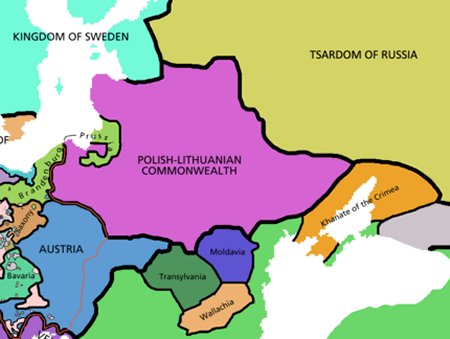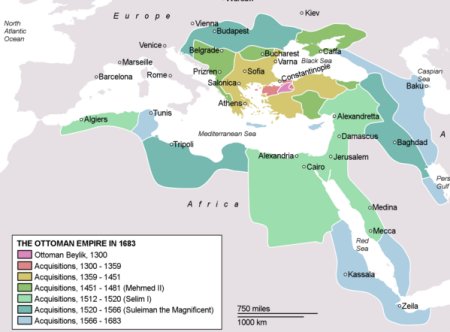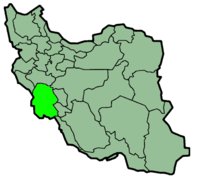My question to Google Answer Service
Where was "The Great Dukedome of Julhuamia" in 1661?
This name appears in an English Parish Register dated 1661 where a
collection of 15 shillings was recorded "For John de Kraino Kramsky in
the Great Dukedome of Julhuamia". The spelling may be imperfect as the
transcription was difficult, and the churchwarden may never have heard
of the place before.
An answer from "Scriptor".
[Copyright of Google Answer Service]
Dear doxeyman,
I have consulted various sources both online and printed. After
careful consideration, I came to the following answer:
The "Great Dukedom of Julhuamia" must actually be the Great Dukedom of
Lithuania! There is no other possible answer. I studied maps showing
17th century Europe. Lithuania was the only Great Dukedome existing at
that time with a name resembling the entry in the old Parish Register.
Even without a spelling mistake by the clerk who wrote those lines,
the handwritten capital "L" might very easily look more like a "J",
and the "it" can indeed resemble a "ul".
And there are other hints that "Julhuamia" is really Lithuania.
"Kramsky" or "Kramski" is clearly a Slavic surname, and I found it
being common in Poland. So the person mentioned must be from Eastern
Europe. In the 17th century, the Great Dukedom of Lithuania was part
of the Kingdom of Poland. However, I have not been able to find out
the meaning of "Kraino", although it clearly sounds and looks Polish.
This part of the person's name possibly refers to a place in old
Lithuania that has changed its name in the meantime or has even ceased
to exist. It is necessary to know that the former Great Dukedom of
Lithuania was geographically not identical with modern Lithuania; in
fact, it was much larger. It reached from the Baltic Sea to the Black
Sea, including parts of today's Poland, Estonia, Lithuania, Latvia,
Belorussia, Russia, the Ukraine and Moldovia. It was a large realm,
and searching a village that existed somewhere in this wide land over
300 years ago may be futile.
All I found is a modern village in Poland, Krainow north of Lublin.
But it was never part of the Great Dukedom of Lithuania. In case this
is the Kraino from the old register, the clerk used the name
"Lithuania" for Poland as a whole. Maybe this was logical from his
point of view, since Lithuania made the bigger part of the united
Kingdom of Poland and Lithuania.
Sources used:
Atlas zur Universalgeschichte, published by List, 1980.
ISBN 3-471-40430-9
Großer Historischer Weltatlas, Vol. 3,
published by Bayerischer Schulbuch-Verlag, 1978
Lubelskie Province Place-finder: Ryki Gmina Page,
by PolandGenWeb, 1999.
http://www.rootsweb.com/~pollubel/pryki/lublin4p1.html
Global Lithuanian Net: Resources of Lithuanian History
http://www.lithuanian.net/resource/history.htm
Search terms used:
Kramski lithuania
http://www.google.de/search?hl=de&ie=UTF-8&oe=UTF-8&newwindow=1&
q=Kramski+lithuania&meta=kraino poland
http://www.google.de/search?hl=de&ie=UTF-8&oe=UTF-8&newwindow=1&
q=kraino+poland&meta= "grand dukedom" lithuania
http://www.google.de/search?hl=de&ie=UTF-8&oe=UTF-8&newwindow=1&
q=%22grand+dukedom%22+lithuania&btnG=Google-Suche&meta=krainow
http://www.google.de/search?hl=de&ie=UTF-8&oe=UTF-8&newwindow=1&
q=krainow&meta=
Hope this helps!
Regards,
Scriptor
Request for Answer Clarification
Hi Scriptor,
That's a great answer, first time I've had an answer to my
question for 3 years. But I've changed the goalposts, just noticed two
more placenames:"Susiana" and "Cusestan" added under "Julhuama" in a
different hand. Please look at
http://www.wirksworth.org.uk/a87-kram.htm which I hope tells the whole
story so far, plus a scan of the writing concerned. Hope these names
can help further. May I have your permission to add your replies to my
website at
http://www.wirksworth.org.uk, which is the largest study of an English
Parish on the Internet.
Best wishes, Doxeyman
Clarification of Answer by scriptor-ga
[Copyright of Google Answer Service]
Dear doxeyman,
The words "Susiana or Cusestan" are highly interesting. There were, as
far as I can tell, no such places in former Poland-Lithuania. But
"Susiana" and "Kusestan" were regions of Persia.
It is only a guess, but here is what I think might be a possible
background of the register entry: Poland-Lithuania in the 17th century
had a border with the Turkish (Osman) Empire in the south, in the
Moldovian and Crimean region. There was always fighting along the
borderline, even when there was no real war. Maybe John (or Jan, as
it would be in Polish) of Kraino Kramsky was captured by Muslims
raiders during such a conflict and sold as slave or something similar
to Persia. This might sound melodramatic, as if taken from a cheap
novel. But such things happened very often in those times. In fact,
Christians kidnapped and enslaved by Muslims in South-East Europe were
so common that in many European countries there were slave funds. The
donations were used to free such persons from slavery in Muslim
countries by buying them.
Maybe friends or relatives of this John of Kraino Kramsky gave money
on his behalf in a similar situation. But this is, of course, only
speculation. I can't prove it.
As for using my answer on your website: Please ask the Google Answers
Editors for permission to do so, since the answer text is copyrighted
intellectual property of Google. You can e-mail them:
Answers-Support@google.com
Best regards!
Scriptor
[See maps of the area to partially confirm this - Ed]
|
Tom emails:
22 Jul 2008
Dear John,
I read your article Persia to Wirksworth, and thought the following
may be of interest.
My Polish partner says that Kraino Kramsky is the old Polish for Crimea.
I hope this may be of interest to you.
All the best,
Tom.
[Thanks Tom, I'm trying to follow this up, but haven't
yet found anyone who knows Old Polish! Can a reader help?]
|
Europe 1648.
The Polish-Lithuanian Commonwealth was one of the largest and
most populous countries in 17th-century Europe.

Ottoman Empire 1683. Land including Persia and stretching almost to
Crimea was aquired by the Ottoman Empire 1566-1683.
In 1604, under the order of Shah Abbas I,
tens of thousands of Armenians were deported to Persia.

|
The name Crimea takes its origin in the name of a city of Qirim
(today's Stary Krym) which served as a capital of the Crimean
province of the Golden Horde.
Crimean Tatars introduced raids into Ukrainian lands,
which were used to get slaves to be sold on markets.

Khuzestan is one of the 30 provinces of Iran.
Susa is one of its major cities.
Hence the names Susiana and Kusestan.
|